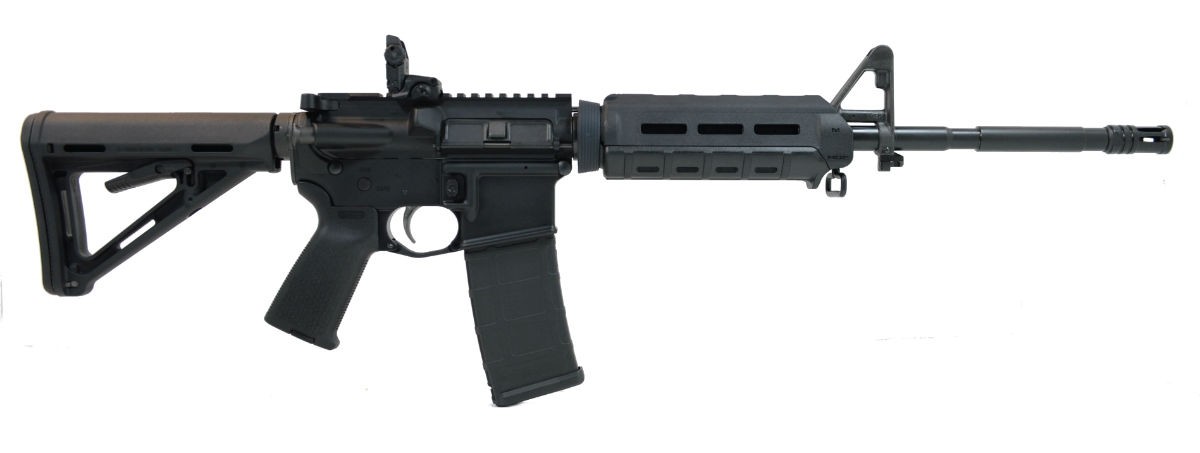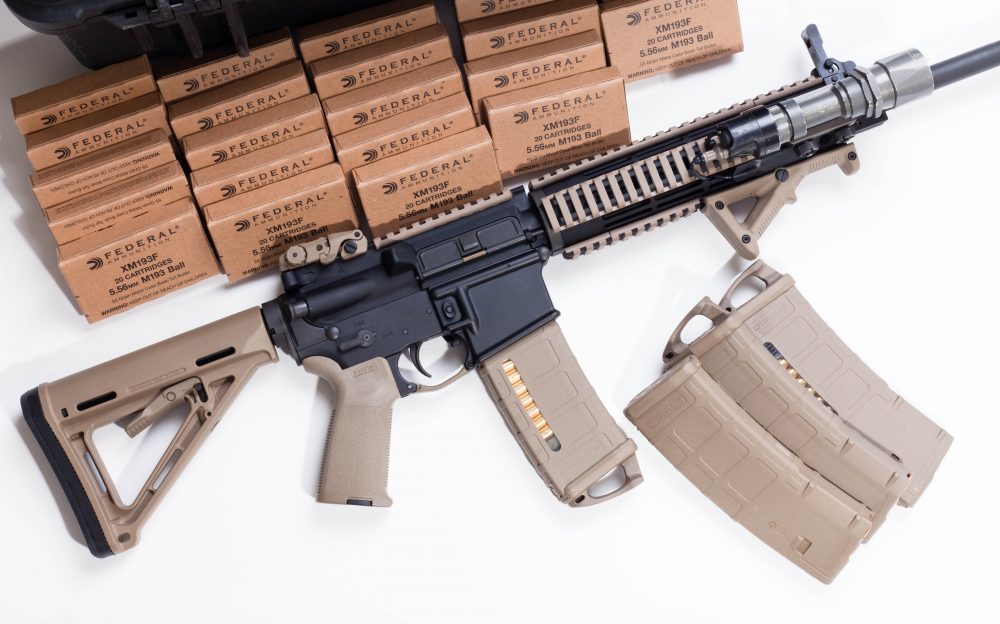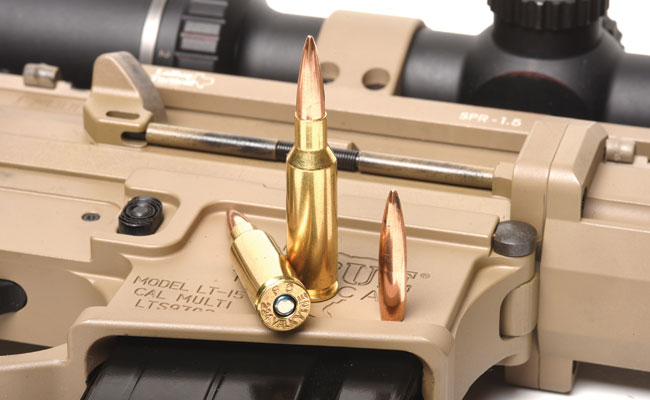The AR-10 and especially the AR-15 are two of the best-known rifles currently – or probably ever – available.
Gun sites like this one talk about these two rifles all the time, but usually individually.
Yet the AR-10 and AR-15 have played inarguably vital roles in military and firearm history, both in the United States and abroad.


Furthermore, the stories of their development are so inextricably linked that talking about the history of one without talking about the history of the other doesn’t tell the whole story.
Today, we want to make sure that you have the whole story. We wanted to compare these two rifles to help you learn the differences between the two and, if you’re interested in purchasing one of them, help you figure out which rifle is best for you.
Armalite: The “AR” in AR-10 & AR-15
Let’s start by talking about the history of Armalite, the company that originated the AR-10 and AR-15.
Armalite was founded by George Sullivan with funding from Fairchild Engine and Aircraft Corporation after Fairchild’s president, Richard Boutelle, became interested in entering the small arms industry.

At the time, Armalite was tiny, working out of a small machine shop in Hollywood, so they only focused on improving current weapons and selling the designs to manufacturers rather than producing new ones.
The first AR rifle, the AR-1 Parasniper, was developed in 1952.
The Parasniper was designed to be exactly what it sounds like: a light, short rifle that paratroopers could easily carry while jumping out of an airplane, plummeting towards the ground, and pulling their parachute cord. Only 25 AR-1 Parasnipers were produced.
Regardless, Armalite became a formally incorporated division of Fairchild in 1954.
Shortly after, Sullivan was at a range testing a prototype for a follow up to the AR-1, where he met Eugene Stoner, a small arms designer. Sullivan immediately hired Stoner to be Armalite’s chief design engineer, changing the game for Armalite.
In 1956, Armalite released not one, but two different aircrew survival rifles designed for use by airmen who’s planes had been shot down or crashed, especially in remote locations or behind enemy lines.
Both the AR-5 and its civilian version, the AR-7, could be disassembled and their components stored in the stock to make the rifle easier to store and carry and to keep the components protected from the elements.

Henry Survival Rifle AR-7
Pros
- Lightweight, Compact, Simple to use
- Self-contained when stored, Waterproof, Easy to reassemble
Cons
- Sight style is a bit dated
Both of these rifles went into production, and the United States Air Force adopted the AR-5 under the name the MA-1 Survival Rifle.
The Origins of the AR-10
Meanwhile, during 1955 and 1956, Stoner was also prototyping the AR-10.
Armalite entered an early version of the AR-10, chambered in 7.62x51mm, into a contest for the US government to select a replacement for the M1 Garand. The AR-10 did not perform well in testing – the aluminum/steel composite barrel split during a torture test – and lost to the far more thoroughly test M44E4, manufactured by Springfield Armory and adopted as the M14.

However, Armalite continued to modify and improve the AR-10’s design and signed a five-year contract with the Dutch arms manufacturer Artillerie Inrichtingen (AI), allowing them to produce far more AR-10s that Armalite could hope to manufacture on their own.
Armalite did manage to sell AR-10s to Guatemalan, Burman, Italian, Cuban, Sudanese, and Portuguese governments, but only to the tune of about ten thousand rifles.
In response to these poor sales, Fairchild elected not to renew the contract with AI, and Armalite instead turned its focus towards improving a prototype for a smaller AR-10 chambered for .223 Remington which would meet the US Air Force’s requirements.

This prototype would eventually become the AR-15.
The Origins of the AR-15
The AR-15 was designed for its own testing for adoption by the US military. This time the Army was looking for a single rifle that could replace five different guns: the Browning Automatic Rifle, the M1 Garand, the M1 Carbine, the Thompson Submachine Gun, and the M3 “Grease Gun”.
In 1958, Army Chief of Staff Maxwell Taylor chose the M14 over Armalite’s submission even though tests showed that the AR-15 was three times more reliable than the M14 and provided twice the firepower and carryable ammo.
Discouraged by financial issues and by losing out once again, Armalite sold the rights to the AR-10 and AR-15 to Colt in 1959.
Colt immediately redesigned the AR-15 for mass production, with the most significant change is moving the charging handle to the end of the receiver, like it was on the AR-10.

Colt quickly saw success with the AR-15 in small markets, but major success came in 1960 when General Curtis LeMay, Vice Chief of Staff of the Air Force, saw a demonstration of the AR-15. He ordered 8,500 of the rifles as a pilot survival rifle.
At the same time, the Army was continuing testing on the AR-15 and found that the AR-15 was much easier to shoot than the M14 and performed nearly twice as well in marksmanship trials.
So it seems like when LeMay was promoted to Chief of Staff of the Air Force in 1961 and requested another 80,000 AR-15s, getting those rifles should have been no problem.
However, General Maxwell Taylor had since become the Chair of the Joint Chief of Staff, a promotion that apparently did not come with an improved ability to choose a decent rifle, and denied the request. LeMay and Taylor continued to butt heads over the AR-15 even as the Vietnam War began.
LeMay would become vindicated, however, when the M14 could not be produced fast enough to meet demand and the AR-15, found to be the only rifle that could be produced in sufficient quantities, replaced the M14 for all branches of the military.
The rifles that Colt designed for the military were adopted as the M16.
In hindsight, we can see that despite the hardships that Armalite faced, the sale of the AR-10 and AR-15 to Colt and the following redesign were the rifles’ saving grace, as Armalite would never have been able to produce adequate numbers of the rifles on their own.
Under Colt’s control, the AR-15 would go on to rival the AK-47 both on the battlefield and in popularity.
Today’s AR-10s
While the original AR-15 was a scaled down version of the AR-10, nowadays it’s essentially the reverse. Modern AR-10s are basically larger versions of Colt’s AR-15 design.
The AR-10 is now used by some militaries and police forces, and semi-automatic versions are in high demand among civilians. Though not as popular as the AR-15, the AR-10 is particularly sought after as a long-range rifle.

Primary Weapons AR-10
Pros
- 6.5 CM is perfect for reaching out past 1000 yards
- Tactical, defensive, and hunting rifle
While the original AR-10 was only available in 7.62×51, AR-10s are now available in various long action calibers, including 6.5 Creedmoor, which was recently adopted by the US Special Operations Command (USSOCOM).
Today’s AR-15s
The AR-15 has been called “the most popular rifle in America” and seem to be produced by anyone who can manage to get their hands on the necessary equipment.
There have been a few improvements to the rifle as technology has advanced, but the design of the rifle has mostly stayed the same since Colt’s redesign.
However, like the AR-10, the AR-15 has also expanded its caliber offerings to also include modern cartridges, such as 6.5 Grendel and 300 Blackout.
Choosing the AR-10
Because the AR-15 is more popular than the AR-10, you might assume that it’s the better choice, but that’s not necessarily the case. Which rifle is better for you depends on what you need and want from your rifle.
The AR-10, especially in its modern incarnation, has greater stopping power than the AR-15 and delivers more power and accuracy at long distances.
This makes it a great choice for long shots at the range, as well as for long range hunting or even closer range hunting of dangerous game, like bears or wild hogs.
A well-placed bullet from an AR-10 will stop pretty much any game you’ll encounter, at least in the United States. If that first shot isn’t so well placed, the AR-10 can also fire off the follow-up shot very quickly.

When it comes to long range target shooting, the AR-10 isn’t as accurate as some high-end bolt guns, but in the right hands the AR-10 can still hold its own, and at a much lower price point.
Speaking of price, one disadvantage of the AR-10 compared to the AR-15 is the price. The size of the AR-15 and especially the massive number of competing AR-15 manufacturers has driven down the price of the AR-15, making it, on average, a great deal cheaper than the AR-10.

DPMS Oracle AR-10
Pros
- High Stopping Power
- Greater Power and Accuracy at Long Distance
- Quick Follow-up Shots
Cons
- More Expensive
- Heavier
- Compatibility and Upgrades Are Challenging
In addition, if you want to upgrade or build your own AR-10, there are plenty of options for parts and accessories, but nothing close to the variety available for the AR-15.
Choosing the AR-15
You may see some AR-15s that are designed for improved stopping power and accuracy, but these rifles don’t measure up in these areas against the AR-10. Instead, they’re chosen for the benefits of the AR-15 with improved performance.
After all, we don’t all need the range or power of an AR-10 and may have a hard time justifying that extra cost for features we won’t truly enjoy and appreciate.
Again, that doesn’t mean the AR-15 is just a low budget AR-10 substitute or that it isn’t as good of a rifle. The AR-15 is great at what it’s designed to do.

Palmetto State Armory PA-15
Pros
- Budget Friendly
- Reliable
- Easy to Upgrade
The AR-15 is an excellent general purpose rifle. After all, it was initially designed to replace five different guns. It can be depended on to make shot after shot with reliable accuracy and without malfunctioning, and it’s easier to shoot than the AR-10, with less recoil and an easier to manage size.
The AR-15 is also more affordable to shoot than the AR-10. I know, we talked about the rifle itself is less expensive, but the ammunition is as well.
Setting aside the cost of the rifle, each shot from an AR-15 costs less than one from its big brother. AR-15 rounds are also easier to find in stores, which isn’t particularly surprising.
After all, the AR-15 is the most popular gun platform in the US and around the world, with the possible exception of the AK platform. You can find AR-15s and their magazines, parts, accessories, and ammunition just about anywhere that sells firearms.
That also makes it easy to build or improve your own AR-15, even with little to no gunsmithing experience or tools, which in turn means that you can quickly and easily reconfigure your AR-15 to optimize it for different needs.
In summary:
Pros
- Incredibly reliable,
- Lower cost,
- Wide selection of easy to find rifles, parts, and accessories.
Cons
- Less powerful,
- Weaker performance at long range.
Final Shots
Whether you decide to purchase a completed rifle or build your own, both the AR-10 and AR-15 are great options.
If you want a rifle that you can rely on for defense against even large wildlife or use to take shots past about 800 meters, then the AR-10 is for you. On the other hand, if you want a reliable, jack of all trades type rifle, then the AR-15 is the intuitive choice.
And if you still can’t choose, I’d recommend the AR-15. It’s more affordable to not just buy but also to maintain, and can easily be upgraded for a variety of purposes.
Or, if you have the budget, you could just get both and enjoy the perks of each.
What did you pick, the AR-10 or AR-15? Have both? Let us know in the comments!









I WANT an AR10, but do not need it. I opted for the 6.8SPC II as my AR10 stand in. Doesn’t do the distance or foot pounds, but 300 yards and under, surpasses the AR15 5.56 easily. Also does short barrels well.